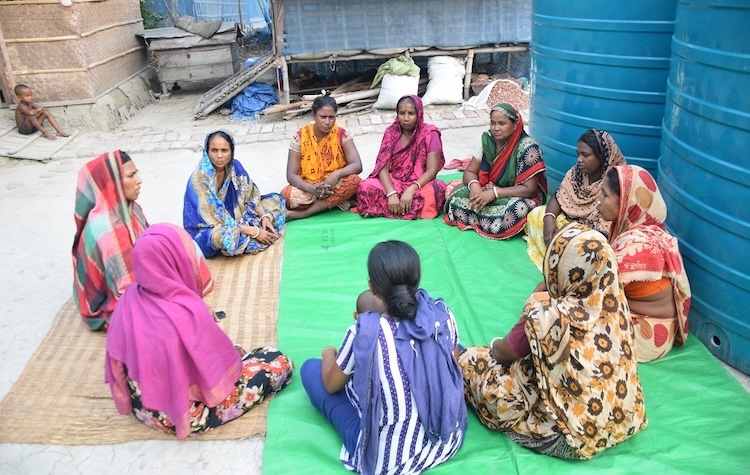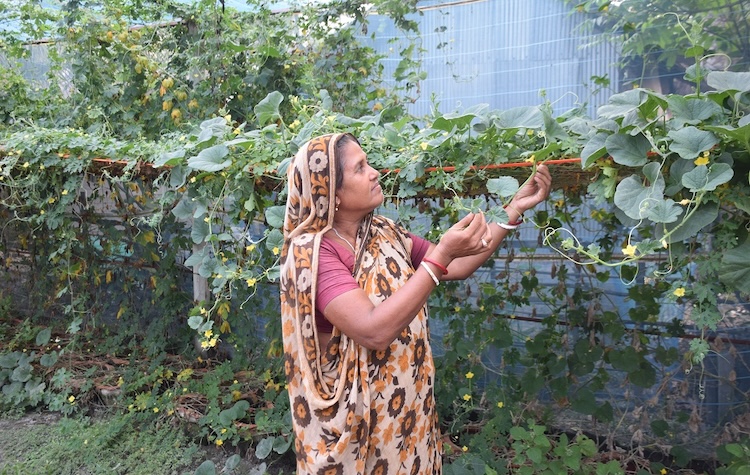By Rafiqul Islam Montu
ASSASHUNI, Bangladesh | 14 August 2024 (IDN) — Martha Achary, 45, and her team members were irrigating the agricultural farm one winter morning in November. The farm is surrounded and covered with blue thick netting. Adjacent to the farm are two large water drums; In which 5000 liters of water was stored during monsoon. Every morning and afternoon the farm vegetables are irrigated from water stored in drums.
“Soil and water are salty. Absence of freshwater reservoirs. Because of this it was not possible to grow vegetables at home. Vegetable farms were burnt by salinity. It was not possible to grow vegetables in houses. We are growing vegetables in this way to avoid salinity. From here we are able to meet the family’s vegetable needs a lot,” said Martha Achari explaining the reasons for alternative vegetable cultivation.

The story is from Baradal village in Assashuni upazila (sub-district) of Satkhira district on the southwest coast of Bangladesh. The women of the Christian neighborhood of this village have taken this exceptional initiative of collective vegetable cultivation. Martha Achari is leading this team. This group of women leases a 5-decimal plot of land from a villager and practices innovative farming, called ‘hydroponic farming’. In this method the whole land is surrounded with thin dense net. Vegetables are grown in tubs made of clay. Biofertilizers have been used in tubs to prevent soil salinity. Instead of salt water, stored rainwater is used in vegetable fields.
Not only Martha Achari of Baradal village and her team members, many other women of Assashuni upazila are involved in such innovative farming methods.
Agriculture at risk due to salinity
Extreme weather events are affecting people in southwestern Bangladesh the most. Agriculture in the region is at risk due to increasing sea level rise, frequent cyclones, droughts, rising temperatures, increasing salinity levels of soil and water etc. Many farmers in the region, who have earned their livelihood through farming, are now being forced to leave agriculture. Salinity in soil and water increased after Cyclone Aila in 2009. After Cyclone Amphan in 2020, many areas were submerged in salt water for more than two years. This has affected agriculture.
Researchers says salinity is increasing, driven by a variety of factors, including rising seas. According to the country’s Soil Resources Development Institute, salinity levels in Bangladesh have increased by more than a quarter in the past three and a half decades. Salinity in the Rupsa river in Khulna district has risen from 0.7 ppt in 1962 to 16.8 parts per trillion (ppt) in 2011, with a 2022 government report warning that rising sea levels will exacerbate the problem in the future.
After visiting many villages of Assashuni Upazila, it was found that once productive fertile lands have fallen due to salinity of soil and water. Once there were many vegetables in the house. But now vegetables cannot be cultivated due to salinity. Not only Assashuni, many upazilas (sub-districts) of Khulna and Bagerhat districts are under threat of agriculture due to salinity.
Women-led innovative agriculture

Women are leading innovative agriculture in salinity-prone areas. Other women, including Martha Achari and Sharifa Khatun of Baradal village, are now becoming proficient in salt tolerant sustainable agriculture. These women themselves are working on the farm—making vegetable tubs with compost, planting vegetables in the tubs, tending the fields and selling the vegetables in the market. Roshan Ara Begum of Pirojpur village in Asashuni, Rasheda Begum of Padma Beula village, Fatematuz Zohra of Rajapur village, Selina Begum of Anulia village, Mana Parveen, Sabina Yasmin of Nakna village, Rizia Khatun of Laskari Khazra village and many other women have joined this innovative agricultural initiative. .
How are women benefiting from this agricultural initiative? Answering this question, Martha Achari of Baradal village said, ‘Firstly, this agricultural farm meets the nutritional needs of our families. Earlier we had to buy vegetables from the market at high prices. There was no opportunity to grow vegetables in the house yard. Secondly, money from selling vegetables is being deposited in the account of party members. About ten thousand taka (about USD 85) worth of vegetables are sold from the farm in a month. Thirdly, we are pioneering climate-resilient agriculture through innovative agricultural technologies.’
Sustainable agriculture initiative has been taken in Asshasuni upazila (sub-district) on saline land through innovative technology. About 3000 women have been involved with it. The Gender-Responsive Coastal Adaptation (GCA) project is empowering women in this innovative agricultural technology. The United Nations Development Program (UNDP) is providing technical support for the implementation of the GCA project jointly funded by the Green Climate Fund (GCF) and the Government of Bangladesh (GoB).
GCA projects are working in Satkhira and Khulna, the most disaster prone coastal regions of Bangladesh. The project is implementing climate resilient livelihoods among coastal women in the area. Hydroponics is one of those options.
Mohammad Iftekhar Hossain, Project Coordination Specialist of Gender-Responsive Coastal Adaptation (GCA) said, ‘I’m pleased to witness the tangible outcomes arising from incorporating the environment friendly practices within our coastal communities through our project. Our main objective has been to promote climate resilient livelihood techniques while reducing the use of plastic. In Assasuni, we have adopted earthen pots in hydroponics practice instead of plastic tubs, by doing this we are taking a modest step towards reducing plastic waste and promoting eco-consciousness. We are encouraged by the results achieved so far and remain committed to creating a cleaner and more sustainable environment for everyone involved.’
How is hydroponics useful in climate-prone areas?

Hydroponics is an agricultural method; Which is particularly beneficial in the context of the coastal region of Bangladesh. This is useful for the effects of climate change, including sea level rise, increased salinity and extreme weather events. It uses a nutrient-rich water solution instead of soil to grow plants. This method offers several advantages over traditional farming methods, including less water use, less harmful pesticides and herbicides, and higher yields in less space.
One of the most notable advantages of hydroponics is its water efficiency. In coastal areas of Bangladesh, freshwater is a scarce resource, and saltwater intrusion due to sea level rise is a growing concern. Hydroponics will help conserve water by recirculating it within the system. This approach will reduce the need for freshwater inputs. Hydroponic systems can be set up using purified water; Which can be especially beneficial in salt water areas.
This approach can also help farmers in coastal areas of Bangladesh to overcome challenges caused by poor soil quality. In many parts of coastal areas, soil salinity is a major problem, making it difficult for farmers to grow crops using traditional farming methods. Hydroponic farming does not depend on soil, allowing farmers to grow crops using water soluble mineral nutrient solutions. This eliminates the need for soil. Making hydroponic farming an ideal solution for areas such as; Where soil quality is poor. This cultivation can be particularly beneficial in the context of coastal areas.
GCA sources say the project aims to make communities more resilient to climate change. The initiative is addressing significant barriers faced by small-scale farmers, fisherfolk and agricultural laborers in diversifying their livelihoods. Empowering women through necessary skills, knowledge and investment by forming Women Livelihood Group. They are moving towards climate-resilient livelihoods. The initiative is helping to better protect and adapt these livelihood strategies to evolving climate risks.
Climate-resilient agriculture needs to be expanded
Sources from the Agricultural Information Service of the Government of the People’s Republic of Bangladesh says that in 1998, scientists of the Bangladesh Agricultural Research Institute first started thinking about the hydroponic system. Research on this topic began in 2006. As a result of continuous research, in the fiscal year 2011-12, this institution was able to produce twelve economic crops through hydroponic culture. Later this number increased. Various government and private institutions have joined the crop cultivation extension program in this manner and interested farmers are coming forward.
Dyuti Krishna Sarkar, Sub Assistant Agriculture Officer working in Pratapnagar Union said, “Pratapnagar Union of Assashuniya Upazila (sub-district) of Satkhira district has been affected by the disaster. Most of the land and water in this region has salinity. Here the hydroponic method is effective. By cultivating vegetables in this way, the community here benefits. The fixed cost in the first stage of cultivation in this method is slightly higher. However, the structures will last for a long time and in later years, excluding these fixed costs, the cost of growing vegetables is not much”.
He said, “There is waterlogging in various places of Pratapnagar Union of Asashuni Upazila since Cyclone Amphan. Due to salt water, it is not possible to bring crops under cultivation in those areas. If the method is applied there, it is possible to advance in agriculture. Hydroponic system is a technology that does not require any soil. It is also called soilless farming. There is no fear of seed loss if this method is cultivated. This approach needs to be extended to climate-critical areas.”
Zakir Hossain Khan, Climate and Renewable Finance Analysts, said: “The southwest coast of Bangladesh is more vulnerable to the effects of climate change. Agriculture is severely disrupted due to frequent cyclones and excessive salinity. As a climate-tolerant solution in the waterlogged area hydroponics can be an effective option for growing crops than the soil-grown crops. comparing the nutritional content of food grown hydroponically with that of soil-grown plants that have acceptable quality in nutrient level. The National Adaptation Plan has adopted this as one of the adaptation options. but that should be the least option while survival is a grave challenge. But challenges remain, as there is no guarantee regarding the nutritional quality of produce since the quality of plants depends on water quality, nutrient solution, and environmental conditions”. [IDN-InDepthNews]
Photo: Martha Achari and her team members are busy tending hydroponic vegetable farm in Baradal village. Credit: Rafiqul Islam Montu


